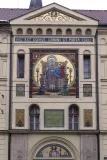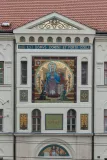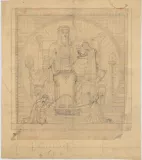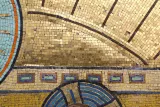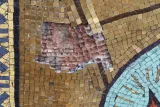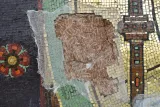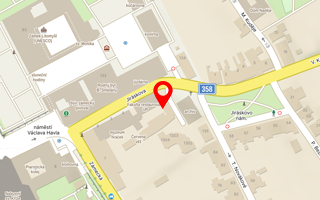Carried out by: BcA. Ivana Milionová, BcA. David Svoboda, DiS., BcA. Adéla Škrabalová (1st and 2nd-year students of Master’s degree programme), MgA. Petr Hampl and František Tesař
Teaching supervision: Mgr. art. Jan Vojtěchovský, Ph.D.
The mosaic decoration of the front facade of Our Lady of the Rosary church in Žižkova street, České Budějovice, is composed of seventeen individual sections. It is one of the first projects of mosaic makers in the Czech lands. The design was created by Benedictine artist Jaroslav Pantaleon Major in the Beuron style. The project was carried out in 1903-1904 by “the first Czech mosaic maker” Viktor Foerster. The church of Our Lady of the Rosary is part of the Congregation of the Blessed Sacrament (the Sacramentinos) monastery compound. The mosaic was created in cooperation with the brethren of the order.
In 2017, the mosaic decoration underwent a restoration survey and intervention associated with the renovation of the facade. First, art-historical, restoration and laboratory surveys of the mosaics were performed. They identified the material of the glass mosaic tesserae as a glass of various colours and a gilded glass of different sizes and shapes, most likely of Italian provenance. Foerster himself developed the embedding method and mortar.
The laboratory survey determined the composition of the bedding mortar. It was prepared of lime and very fine-grained lime and silica-based aggregate.
It also contains quite a high proportion of organic binder, most probably oil. The high content of oil may be the cause of the increased thermal-humidity expansion and the subsequent damage. It resulted in detachment of the mosaic glass from the mortar bedding – in particular, moving cavities and open defects where the mosaic tesserae were lost entirely, and the bedding mortar was exposed.
Because grouting test of such cavities did not prove effective, it was necessary to detach individual parts of the mosaic and carry out the embedding process using newly-developed aerial-lime and hydraulic-lime-based mortars. Subsequently, the mosaic was cleaned using water, detergent and a steam cleaner. In the areas of missing mosaic tesserae, the mosaic was reconstructed with a mosaic glass of Italian provenance.
The surveys, development of the restoration materials and the subsequent restoration treatment were all performed within the project with the title Restoration of mosaics of the so-called Czech mosaic school made of glass and stone. Within the survey, the colours of the facade coating were also investigated. Based on the findings, a decision was made to apply the original cool colour tone.

